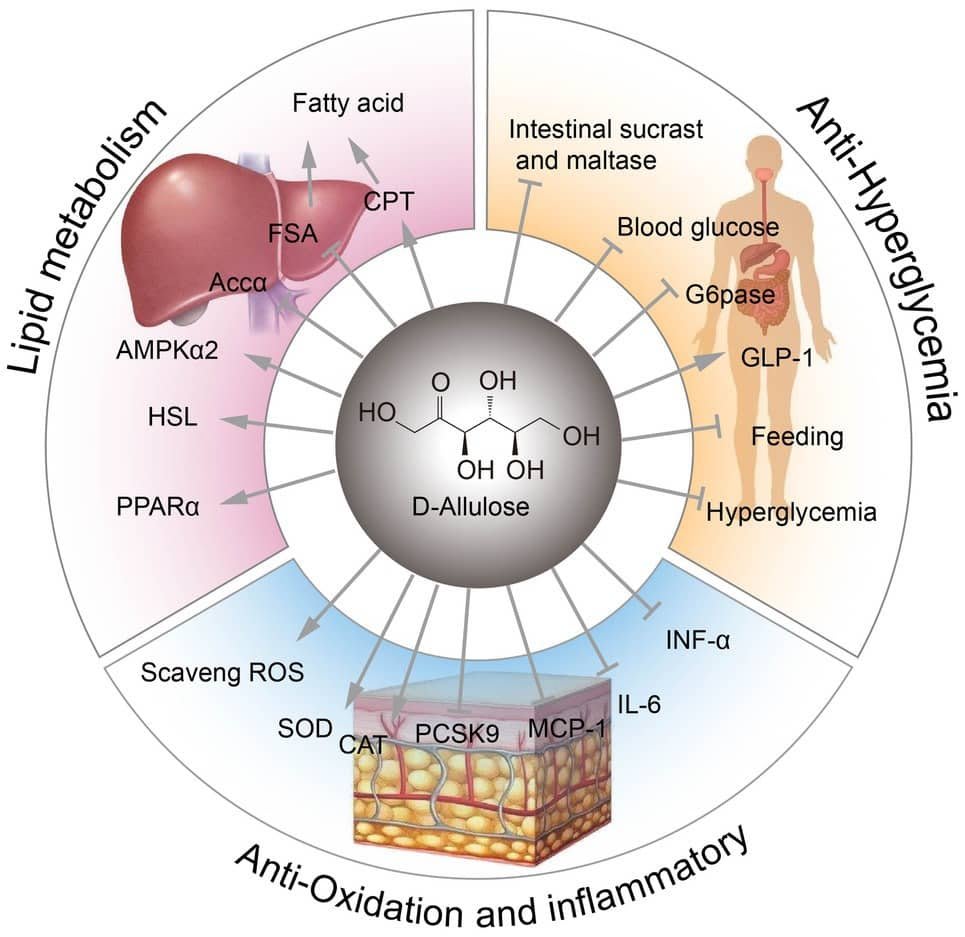Sugar detox doesn’t have to mean giving up sweetness entirely. The exciting world of Next-Gen Sugar Alternatives: Allulose & Tagatose is revolutionizing how health-conscious individuals can enjoy their favorite treats without the blood sugar spikes, crashes, and metabolic disruption that come with traditional sugar. These innovative sweeteners represent a breakthrough in food science, offering the taste satisfaction you crave while supporting your wellness goals.
Unlike artificial sweeteners that often leave an unpleasant aftertaste or raise concerns about long-term health effects, allulose and tagatose are naturally occurring sugars that work harmoniously with your body’s metabolism. Whether you’re following a ketogenic lifestyle, managing diabetes, or simply committed to reducing your sugar intake, understanding these Next-Gen Sugar Alternatives: Allulose & Tagatose could transform your relationship with sweet foods forever.
What Are Allulose and Tagatose and Why Do They Matter?

Traditional sugar, or sucrose, triggers rapid blood glucose spikes that can lead to energy crashes, increased cravings, and long-term metabolic dysfunction. Next-Gen Sugar Alternatives: Allulose & Tagatose operate through entirely different mechanisms in your body, offering sweetness without the metabolic chaos.
Allulose is a rare monosaccharide naturally found in small quantities in figs, raisins, and maple syrup. Despite having the same molecular formula as fructose, allulose is absorbed differently by the body. About 70% passes through unchanged and is excreted in urine, resulting in approximately 90% fewer calories than regular sugar. The FDA has recognized allulose’s unique properties, allowing manufacturers to exclude it from total sugar counts on nutrition labels.
Tagatose, derived from lactose found in dairy products, represents another fascinating advancement in sugar science. With a glycemic index of just 3 (compared to table sugar’s 65), tagatose provides about 38% of sugar’s calories while delivering comparable sweetness. Beyond its low-caloric impact, tagatose acts as a prebiotic, feeding beneficial gut bacteria and supporting digestive health.
Both sweeteners maintain sugar’s familiar taste profile and functional properties in baking, making them ideal replacements for traditional sugar in recipes ranging from simple beverages to complex desserts.
Health Benefits of These Revolutionary Sweeteners

The health advantages of Next-Gen Sugar Alternatives: Allulose & Tagatose extend far beyond simple calorie reduction. These sweeteners offer unique metabolic benefits that align perfectly with modern health and wellness goals.
Allulose’s most impressive characteristic is its minimal impact on blood glucose and insulin levels. Clinical studies demonstrate that allulose consumption doesn’t trigger the typical glycemic response associated with sugar, making it particularly valuable for individuals managing diabetes or following low-carb lifestyles. Some research suggests allulose may even improve glucose tolerance and insulin sensitivity over time.
The sweetener also shows promise for weight management. Because it provides sweetness satisfaction with virtually no metabolic burden, allulose can help reduce overall caloric intake while maintaining diet adherence. Unlike artificial sweeteners that may trigger increased cravings, allulose appears to satisfy sweet tooth desires without promoting additional food seeking behaviors.
Tagatose brings its own unique advantages to the table. Its prebiotic properties support beneficial gut bacteria growth, potentially improving digestive health and immune function. The glycemic index of 3 means tagatose has minimal impact on blood sugar, making it suitable for diabetic individuals and those following ketogenic or other low-carb approaches.
Both sweeteners integrate seamlessly into popular dietary approaches including keto, paleo, and general clean eating plans. They provide the sweetness necessary for sustainable diet adherence without compromising metabolic goals or triggering the addictive cycle often associated with traditional sugar consumption.
Challenges and Practical Considerations

While Next-Gen Sugar Alternatives: Allulose & Tagatose offer significant advantages, understanding their limitations helps set realistic expectations and optimize their use in your sugar detox journey.
Availability and cost represent the primary challenges for most consumers. These specialized sweeteners typically cost significantly more than traditional sugar and may require sourcing from health food stores or online retailers. However, as demand increases and production scales up, prices are gradually becoming more accessible.
Digestive tolerance varies among individuals, particularly with larger quantities. Some people experience mild gastrointestinal effects like bloating or loose stools when consuming significant amounts of these sugar alcohols, especially during the initial adaptation period. Starting with smaller quantities and gradually increasing intake typically minimizes these effects.
Baking and cooking properties, while similar to sugar, aren’t identical. Allulose doesn’t caramelize exactly like sugar, which may affect the appearance and texture of certain baked goods. Tagatose behaves more similarly to sugar in heat applications but may require recipe modifications for optimal results.
Storage and handling also require consideration. Both sweeteners are hygroscopic, meaning they absorb moisture from the air. Proper storage in airtight containers helps maintain their quality and prevents clumping.
Tips and Trends in Sugar-Free Baking

The landscape of sugar-free cooking continues evolving with technological advances and increased understanding of alternative sweeteners. Next-Gen Sugar Alternatives: Allulose & Tagatose represent just the beginning of a broader revolution in healthy sweetening options.
AI-powered meal planning apps are beginning to incorporate these specialized ingredients into their recipe suggestions, making it easier for home cooks to experiment with sugar alternatives. Applications like Yuka and MyFitnessPal now recognize these sweeteners and can help track their minimal impact on daily macronutrient goals.
Blending different alternative sweeteners often produces superior results compared to using single sweeteners alone. The combination of allulose and tagatose in recipes provides both the bulk and sweetness needed while minimizing any individual sweetener’s potential drawbacks. Many professional sugar-free bakers recommend using allulose for its browning properties alongside tagatose for its prebiotic benefits.
Popular food bloggers and nutritionists increasingly recommend investing in a kitchen scale for precise measurements when working with alternative sweeteners. Unlike sugar, these sweeteners may have different weights and sweetness levels, making accurate measurement crucial for consistent results.
The trend toward fermented and cultured foods pairs excellently with tagatose’s prebiotic properties, creating synergistic effects for gut health when incorporated into homemade yogurt, kefir, or kombucha recipes.
Frequently Asked Questions

Can I substitute allulose and tagatose cup-for-cup for regular sugar in any recipe?
While both sweeteners provide comparable sweetness to sugar, they don’t always work as direct 1:1 substitutions in all recipes. Allulose works best as a 1:1 replacement in most applications, but may not provide the same browning or caramelization as sugar. Tagatose is slightly less sweet than sugar, so you might need about 10% more. For best results, start with tested recipes designed for these sweeteners before experimenting with substitutions.
Are there any people who should avoid allulose and tagatose?
Most people can safely consume these sweeteners in moderate amounts. However, individuals with hereditary fructose intolerance should avoid allulose due to its structural similarity to fructose. Those with severe lactose sensitivity might want to exercise caution with tagatose, though it’s typically well-tolerated since the lactose is converted during processing. As with any dietary change, consult your healthcare provider if you have specific medical conditions or concerns.
How do these sweeteners affect ketosis and blood sugar compared to other sugar alternatives?
Both allulose and tagatose have minimal impact on blood glucose and insulin levels, making them excellent choices for ketogenic diets. Allulose has virtually no glycemic impact, while tagatose’s glycemic index of 3 is significantly lower than other natural sweeteners like honey (55) or maple syrup (65). This makes them superior to many other alternatives for maintaining stable blood sugar and staying in ketosis.
What’s the best way to store these sweeteners and how long do they last?
Store both allulose and tagatose in airtight containers in a cool, dry place away from direct sunlight. They’re hygroscopic (absorb moisture), so proper sealing is crucial to prevent clumping. When stored correctly, both sweeteners maintain their quality for 2-3 years. If clumping occurs, you can often break it up gently or pulse briefly in a food processor to restore the granular texture.
Can I use these sweeteners in beverages and will they dissolve properly?
Yes, both sweeteners dissolve well in beverages, though tagatose dissolves slightly more slowly than allulose in cold liquids. For iced drinks, dissolve the sweetener in a small amount of warm water first, then add to your cold beverage. Both work excellently in coffee, tea, smoothies, and homemade flavored waters without leaving the bitter aftertaste sometimes associated with artificial sweeteners.
Conclusion: Embracing the Future of Healthy Sweetening

Next-Gen Sugar Alternatives: Allulose & Tagatose represent a genuine breakthrough for anyone committed to reducing sugar intake without sacrificing the joy of sweet foods. These scientifically advanced sweeteners offer the rare combination of authentic sugar-like taste, minimal metabolic impact, and additional health benefits that go beyond simple calorie reduction.
Whether you’re managing diabetes, following a ketogenic lifestyle, or simply seeking to break free from sugar’s addictive cycle, these innovative sweeteners provide a sustainable path forward. The investment in slightly higher costs and the learning curve for optimal use pale in comparison to the long-term benefits of stable blood sugar, reduced cravings, and continued enjoyment of your favorite sweet treats.
Ready to revolutionize your sugar detox journey? Start experimenting with these next-generation sweeteners in simple recipes like the chocolate chip cookies above, then gradually incorporate them into more complex creations. Visit sugardetoxlab.com for more innovative sugar-free recipes, subscribe to our newsletter for the latest developments in healthy sweetening, and share your own success stories with these remarkable ingredients in the comments below.







